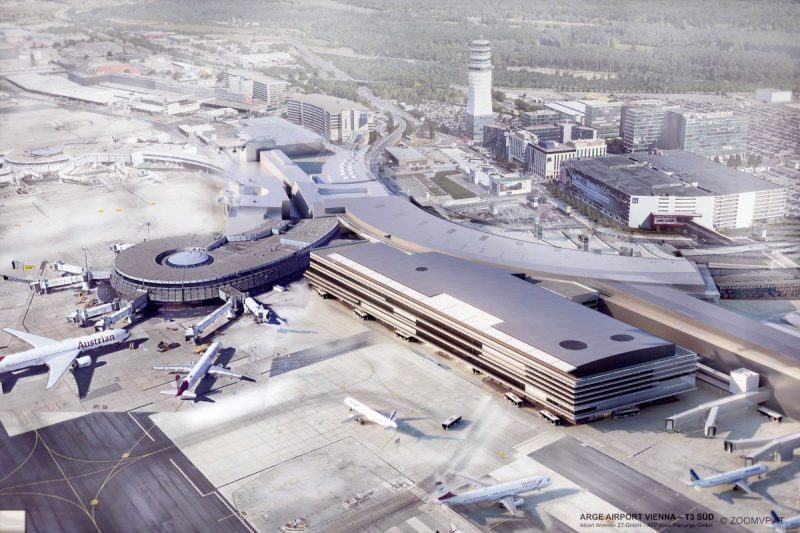There has been a trend at Vienna Airport in recent years: instead of more passenger boarding bridges, additional bus gates are being created again and again. Although the former B gates in the “old building” were abandoned, additional areas were created to replace them. This continues with the construction of the southern extension of Terminal 3.
It wasn't that long ago that the B gates, where only busboarding was carried out, were shut down. It is now in this area a police passport control zone. These gates were already rarely used before. As a replacement, two additional zones were created in the C-gate area where only bus boarding is possible. The first has been in operation for a long time and the second was completed immediately before the corona pandemic and is therefore standing available since the recommissioning of the terminal complex 1+2. In addition, during the pandemic in Terminal 3 on the basement floor F-Gates created another zone for bus boarding. During the crisis there were even in Vienna “double busboarding”.
It has been known for several years that Vienna-Schwechat Airport wants to correct some planning errors that were committed in the past with the help of the southern expansion of Terminal 3, which is now under construction. A closer look at the renderings also shows that there will be fewer passenger boarding bridges in the future.
The “cheap” bus boarding
Many passengers find it “cheap” when boarding is done by bus or even on foot across the apron. In unobjective discussions it is even said that only low-cost airlines do not use passenger boarding bridges. That's not true at all, but it's a subjective perception of travelers who tend to be so-called infrequent flyers. In practice, however, it is actually the case that more and more airlines no longer want their planes to dock on the gangways, because boarding and disembarking takes longer than with walk boarding or bus boarding, as long as there are two entrance doors to the aircraft can be used.
It should also be noted at this point that there are machine types that simply do not have two doors that could be used for boarding or are not suitable for docking on gangways due to their design. For example, the de Havilland Dash 8-400 cannot be placed on standard passenger boarding bridges. At some airports there are a few structures that “virtually” make this possible. For example in Stuttgart: A staircase is placed at the end of the gangway. Passengers then use this to enter the apron and get into the aircraft in the immediate vicinity - depending on the aircraft type, via the built-in airstair or another staircase that is provided.

Airlines want to increase bus and walk boarding
But why is it that Vienna Airport is obviously reducing the number of passenger boarding bridges and at the same time creating additional bus gates? This is primarily due to demand from airlines, as more and more carriers want their passengers to be taken to the plane by bus. They would even prefer so-called walk boarding over the apron. The reasons are obvious: boarding and alighting via gangways takes significantly longer even if, for example, both doors can be used, as is the case with the C-gates at Vienna Airport. Many passengers don't even realize that they have to go down stairs to reach the back door. There are also a few “intelligence bolts” who, as a matter of principle, want to get in at the front even if the seat is in the last row. This cannot be avoided with either bus or walkboarding.
Bus boarding has decisive advantages for airlines: If several doors are available, passengers can get out more quickly. At the same time, the passengers of the next flight can be “temporarily stored” in the apron vehicles and can be boarded into the aircraft immediately after approval by the crew. It is an open secret that more and more carriers are temporarily storing their passengers in buses, stairwells, etc. for half an hour or longer, even though the plane is not yet ready for boarding. This can be very inconvenient for travelers, but the airlines hope it will speed up the boarding process.

Nobody feels entitled
If you ask airports and airlines who decides whether there is “temporary storage” or not, then you pass the buck to each other. The airlines talk to the airports, which would decide whether you get on and off by bus, gangway or via the apron and especially when boarding starts. The airports and ground handling companies point out that the airlines set the rules. In fact: the positions are assigned, but the procedures are definitely determined by the airlines. When assigning gangway or apron positions, the airlines' wishes are taken into account wherever possible. At some airports bus boarding is cheaper than via passenger boarding bridges, at others it makes no difference at all in terms of price. Some carriers even insist that only gangways or only outside positions with bus boarding are used.
But how does it fit with an airport that aspires to become a so-called five-star airport? This is a good question and one has to take into account that the Skytrax rating agency has lost a lot of prestige and credibility in recent years due to a questionable decision. It was only because of an announcement that Lufthansa was temporarily given five stars, although the fifth was then withdrawn at the next opportunity.

Leaky roof
“Five stars” are associated with comfort and special luxury. Terminal 3 at Vienna Airport in particular is very far removed from this claim. To this day, the structure is not even waterproof. In heavy rain, passengers can experience this in the G-gate area, as it rains in many places. Buckets then stand around and cleaning teams are constantly busy wiping away the water ingress.
Many travelers also don't like having to board on the apron in wind and weather. Boarding via passenger boarding bridges is much more comfortable, but more and more airlines no longer want that. However, gangway boarding can quickly become very uncomfortable due to a bad habit that has been practiced more and more frequently at Vienna Airport for several years. Many airlines, including the AUA, let their travelers get into the gangway very early, which is neither air-conditioned nor heated. However, the plane is not yet ready for boarding and so the passengers have to wait. In other words: When it is cold in winter or extremely hot in summer, they are “temporarily stored” close together. The same phenomenon also occurs with bus boarding: temporary storage in stairwells (“waiting for the bus”) or directly in front of the machine on the apron is commonplace. It's often not just about five minutes, but about half an hour or even not a whole hour. With a little better communication this would be more comfortable for travelers, but the fact is: many carriers require ground handling that passengers can board the plane immediately after clearance. The emphasis is on boarding, not just checking your boarding passes.
Vienna Airport provides the infrastructure. To use it, passengers have to pay various fees themselves, such as the passenger fee. It is by no means the case that you only pay for the flight, but the so-called “taxes and fees” include numerous items that flow directly to the airport. There are also other points that airlines have to pay to airports, service providers and authorities.
It is well known that Terminal 3 at Vienna Airport is a faulty design that current management has been working on fixing for many years. The very fact that there was no connection between the existing building and the new building at the time of its opening is emblematic. These had to be or will be created gradually. The southern expansion should make an important contribution, because then the security areas should also be largely connected to one another. There are already a few paths and a shuttle bus, but that is not an optimal solution.

Five stars?
The additional bus gates are intended to further increase capacity. However, this is at the expense of existing gangways, which will no longer exist in this position in the future. Ultimately, it's also about shopping and dining, because this brings in a lot of rent for the airport. The additional areas are quite extensive. You will also earn money from announced lounges, because you get rent from external operators and if you open them yourself, you earn the entry fees yourself, which are paid by the passengers either themselves or through their airline or the card program.
It remains to be seen whether Vienna Airport will actually succeed in becoming a five-star airport through the southern expansion alone, which will primarily bring a new security checkpoint, additional restaurants, shops and lounges as well as bus gates. Ultimately, passengers decide for themselves whether they perceive something as “five stars” or not. Advertising mailings and stickers based on rating agencies like Skytrax don't help at all. What counts for the individual traveler is the individual experience and that is subjective, personal and unique.







 trail (for them it's free to use)
trail (for them it's free to use)